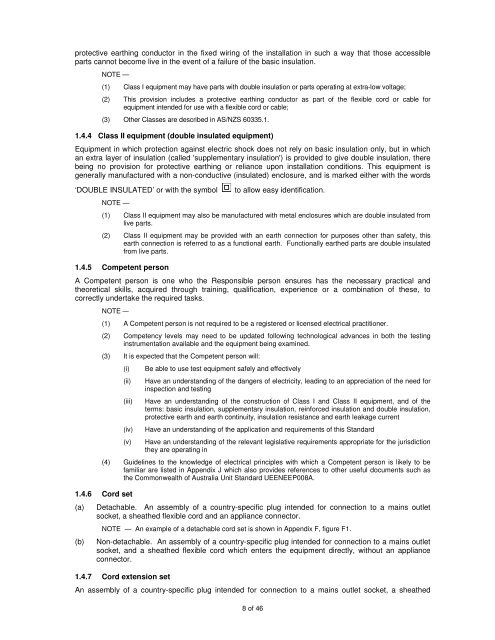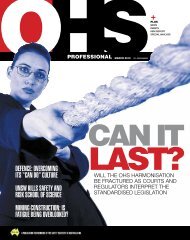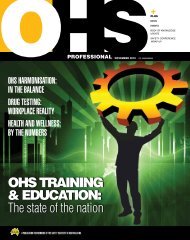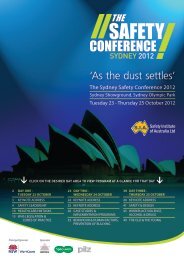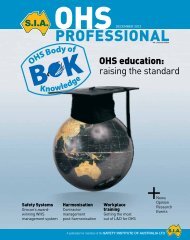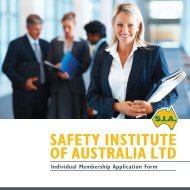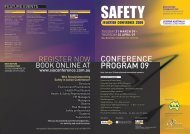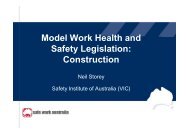In-service safety inspection and testing of electrical equipment
In-service safety inspection and testing of electrical equipment
In-service safety inspection and testing of electrical equipment
Create successful ePaper yourself
Turn your PDF publications into a flip-book with our unique Google optimized e-Paper software.
protective earthing conductor in the fixed wiring <strong>of</strong> the installation in such a way that those accessibleparts cannot become live in the event <strong>of</strong> a failure <strong>of</strong> the basic insulation.NOTE —(1) Class I <strong>equipment</strong> may have parts with double insulation or parts operating at extra-low voltage;(2) This provision includes a protective earthing conductor as part <strong>of</strong> the flexible cord or cable for<strong>equipment</strong> intended for use with a flexible cord or cable;(3) Other Classes are described in AS/NZS 60335.1.1.4.4 Class II <strong>equipment</strong> (double insulated <strong>equipment</strong>)Equipment in which protection against electric shock does not rely on basic insulation only, but in whichan extra layer <strong>of</strong> insulation (called 'supplementary insulation') is provided to give double insulation, therebeing no provision for protective earthing or reliance upon installation conditions. This <strong>equipment</strong> isgenerally manufactured with a non-conductive (insulated) enclosure, <strong>and</strong> is marked either with the words‘DOUBLE INSULATED’ or with the symbolNOTE —to allow easy identification.(1) Class II <strong>equipment</strong> may also be manufactured with metal enclosures which are double insulated fromlive parts.(2) Class II <strong>equipment</strong> may be provided with an earth connection for purposes other than <strong>safety</strong>, thisearth connection is referred to as a functional earth. Functionally earthed parts are double insulatedfrom live parts.1.4.5 Competent personA Competent person is one who the Responsible person ensures has the necessary practical <strong>and</strong>theoretical skills, acquired through training, qualification, experience or a combination <strong>of</strong> these, tocorrectly undertake the required tasks.NOTE —(1) A Competent person is not required to be a registered or licensed <strong>electrical</strong> practitioner.(2) Competency levels may need to be updated following technological advances in both the <strong>testing</strong>instrumentation available <strong>and</strong> the <strong>equipment</strong> being examined.(3) It is expected that the Competent person will:(i)(ii)(iii)(iv)(v)Be able to use test <strong>equipment</strong> safely <strong>and</strong> effectivelyHave an underst<strong>and</strong>ing <strong>of</strong> the dangers <strong>of</strong> electricity, leading to an appreciation <strong>of</strong> the need for<strong>inspection</strong> <strong>and</strong> <strong>testing</strong>Have an underst<strong>and</strong>ing <strong>of</strong> the construction <strong>of</strong> Class I <strong>and</strong> Class II <strong>equipment</strong>, <strong>and</strong> <strong>of</strong> theterms: basic insulation, supplementary insulation, reinforced insulation <strong>and</strong> double insulation,protective earth <strong>and</strong> earth continuity, insulation resistance <strong>and</strong> earth leakage currentHave an underst<strong>and</strong>ing <strong>of</strong> the application <strong>and</strong> requirements <strong>of</strong> this St<strong>and</strong>ardHave an underst<strong>and</strong>ing <strong>of</strong> the relevant legislative requirements appropriate for the jurisdictionthey are operating in(4) Guidelines to the knowledge <strong>of</strong> <strong>electrical</strong> principles with which a Competent person is likely to befamiliar are listed in Appendix J which also provides references to other useful documents such asthe Commonwealth <strong>of</strong> Australia Unit St<strong>and</strong>ard UEENEEP008A.1.4.6 Cord set(a)(b)Detachable. An assembly <strong>of</strong> a country-specific plug intended for connection to a mains outletsocket, a sheathed flexible cord <strong>and</strong> an appliance connector.NOTE — An example <strong>of</strong> a detachable cord set is shown in Appendix F, figure F1.Non-detachable. An assembly <strong>of</strong> a country-specific plug intended for connection to a mains outletsocket, <strong>and</strong> a sheathed flexible cord which enters the <strong>equipment</strong> directly, without an applianceconnector.1.4.7 Cord extension setAn assembly <strong>of</strong> a country-specific plug intended for connection to a mains outlet socket, a sheathed8 <strong>of</strong> 46


